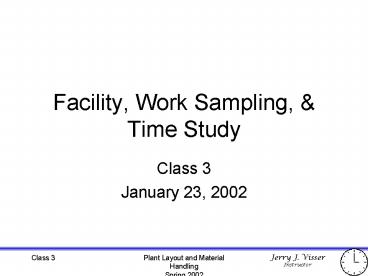Plant Layout and Material Handling Spring 2002 - PowerPoint PPT Presentation
1 / 29
Title:
Plant Layout and Material Handling Spring 2002
Description:
Definition of time study and time standards. Importance and uses of time ... Easy to do with 'cells' and 'floaters' Class 3. Plant Layout and Material Handling ... – PowerPoint PPT presentation
Number of Views:202
Avg rating:3.0/5.0
Title: Plant Layout and Material Handling Spring 2002
1
Facility, Work Sampling, Time Study
- Class 3
- January 23, 2002
2
Todays Topics
- Definition of time study and time standards
- Importance and uses of time standards
- Techniques of time study
- Time standards for manufacturing facilities design
3
What is a Time Standard?
- The time required to product product at a
workstation, with - Qualified, well-trained operator
- Working at normal pace
- Doing specific task
4
Normal pace
- Maintain comfortable pace
- Walking 264 ft/1000 min (3mph)
- Dealing 52 cards into 4 equal stacks
- Filling 30 pin board in .435 minutes. (2 hands)
5
Specific task
- The prescribed work method
- The material specification
- Tools and equipment being used
- Positions of Incoming and Outgoing material
- Additional requirements
6
Importance and Uses of Time Study
- No time standard gt works 60 of time
- With time standards gt 85 of normal performance
- Incentive pay gt 120 of average performance
- (Be careful how standards are set.)
7
How many machines do we need?
- How many pieces needed per shift?
- How much time per part? (std time)
8
Hire how many people?
Operation number
Nut
10
Lathe
Pieces per standard hour
20
Debur
Hours to produce 1,000 pieces
4.33 hours total for 1,000 pieces 43.3 hrs for
10K per week requires more than 1 person
9
How much will product cost?
- Overhead costs per direct labor cost
- Overhead costs per direct labor hour
10
How do we schedule our shop?
- Usually, Production Control has scheduling
software - Uses time standards
- Backward vs. Forward
- Finite vs. Infinite
11
Balancing the assembly line.
- Each operator time content of work
- Break jobs into elements
- Easy to do with cells and floaters
12
How do we measure productivity?
- Goal setting (time standards)
- Comparison of actual performances
- Tracking results (graphing)
- Reporting significant variances
- Taking corrective action to fix
13
How can we pay incentives?
- Productivity improved
- Reduced cost
- Workers pay increased
- Worker moral improved
- Management can abuse this
14
How can we evaluate alternatives?
- Present method and costs
- New method and costs
- Savings Direct labor dollars
- Return on Investment
15
How do we develop a personnel budget?
- Based on time standards
- Cost estimating process
- More than just numberspeople
16
Techniques of Time Study
- Predetermined Time Standard Systems
- Stopwatch Time Study
- Work sampling
- Standard data
- Expert opinion historical data
17
Time Study Procedure
- Select the job to study.
- Collect information about the job.
- Divide the job into elements.
- Do the actual time study.
- Extend the time study.
- Choose number of cycles to be timed.
- Rate, level, and normalize performance.
- Apply allowances.
- Check for logic.
- Publish the time standard.
18
Allowances
- Types
- Personal
- Fatigue
- Delay
19
Methods of applying allowances
- Normal time allowance standard time
- 18.5 hours per 1,000
- Constant allowance total normal time
- Elemental allowance technique
- PFD elemental allowance technique
20
Work Sampling (Konz 1990)
- Problem with Continuous time study
- Required number of observations
21
Representative Sample
- Stratification
- Influence
- Periodicity
- Sampling Procedure
22
Data Gathering
- Man or Machine (who gathers?)
- Reuse data (further comparisons)
23
Data Analysis
- Strata Comparison
- Control Charts
24
Applications of Occurrence Sampling
- For management decisions
- Work vs. Idle time
- Set time standards
25
Steps to make Occurrence Sample
- State the Problem
- Calculate sample size required
- Plan study
- Make study
- Analyze results
- Make conclusions
- Make decision
26
Standard Data
- Machine feeds and speeds
27
Expert Opinion/Historical Data
- Use a supervisor
- How long did it take last time?
28
Which Technique to Use?
29
Quiz 3































